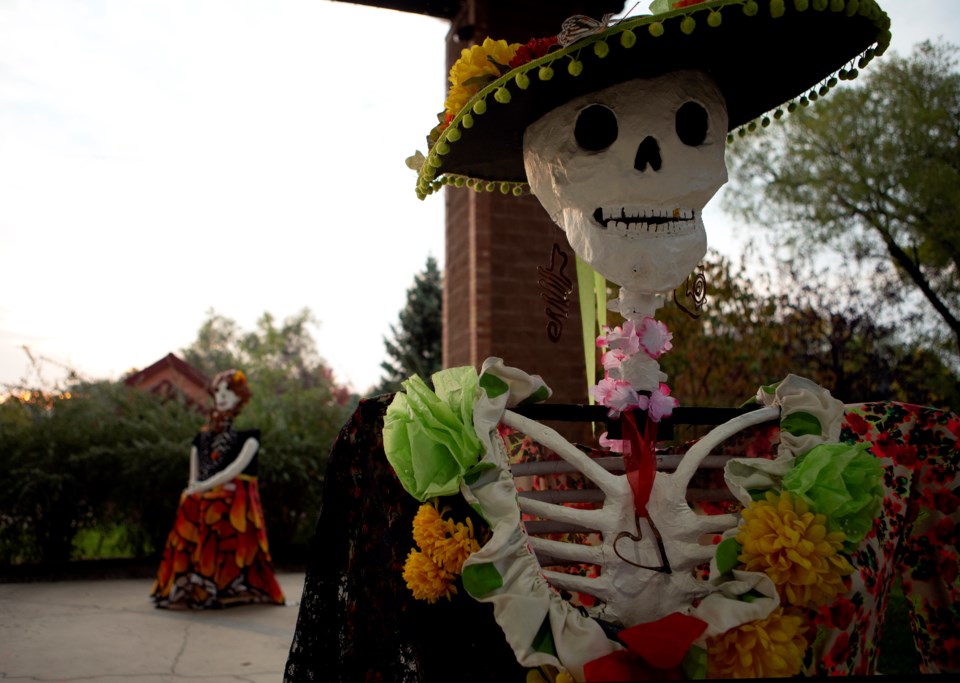Día de los Muertos celebrations in Longmont began early and were scaled down this year with COVID-19 restrictions, but the enthusiasm for the holiday and pride for Latinx culture is unchanged.
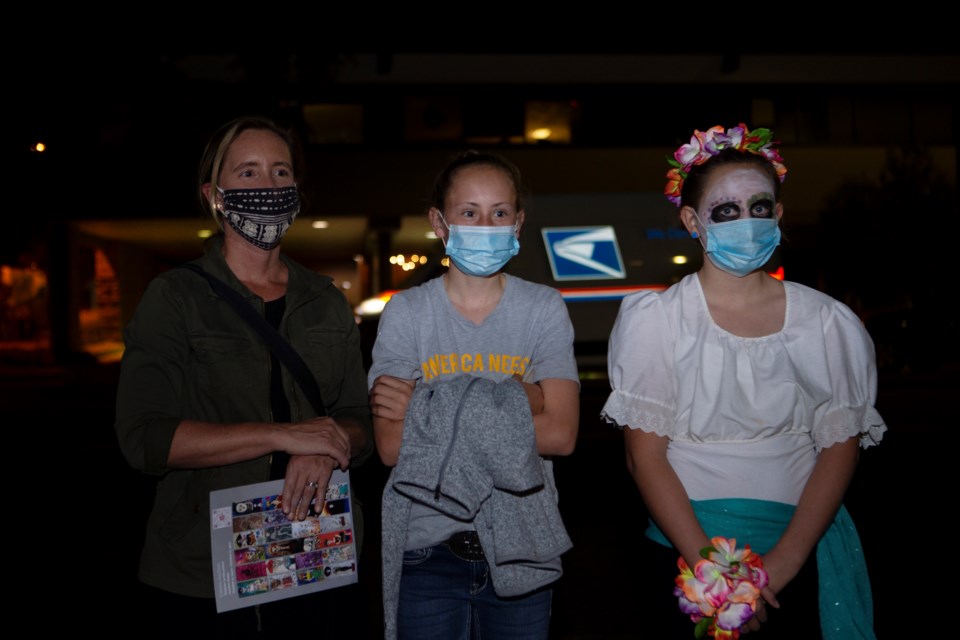 Kathy, Caroline and Clara Kron, Longmont residents, watch Grupo Azteca Tlahuizcalli perform in the parking lot south of the Firehouse Art Center for DÃa de los Muertos on Oct. 9. Photo by Ali C. M. Watkins
Kathy, Caroline and Clara Kron, Longmont residents, watch Grupo Azteca Tlahuizcalli perform in the parking lot south of the Firehouse Art Center for DÃa de los Muertos on Oct. 9. Photo by Ali C. M. Watkins
Traditional Aztec performers danced for four hours straight as spectators, some donning masks with hand painted skull mouths, watched and cheered.
Día de los Muertos, or Day of the Dead, normally is celebrated over the course of three days, beginning at the end of October and lasting through Nov. 2.
But an early celebration of the holiday, organized by Firehouse Art Center, on Oct. 9 commenced in Roosevelt Park.
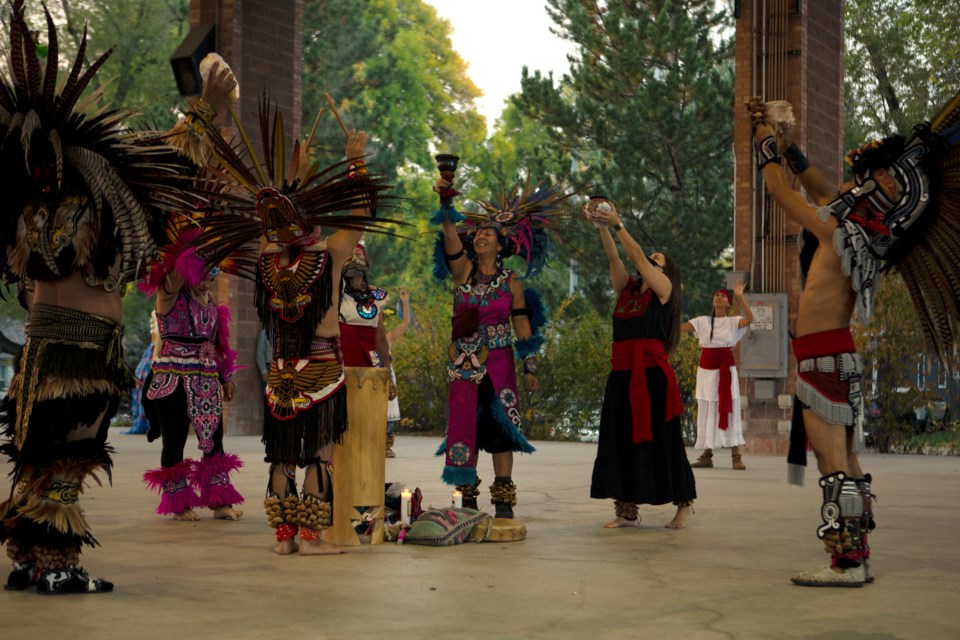 Traditional Aztec dance troupe Grupo Azteca Tlahuizcalli, performs for the DÃa de los Muertos invocation on Oct. 10 at City of Longmont Roosevelt Park. Photo by Ali C. M. Watkins
Traditional Aztec dance troupe Grupo Azteca Tlahuizcalli, performs for the DÃa de los Muertos invocation on Oct. 10 at City of Longmont Roosevelt Park. Photo by Ali C. M. Watkins
The invocation performance was danced by local troupe Grupo Azteca Tlahuizcalli at sunset. The group then led the Gigantes Procession, a parade with large puppet-like structures, throughout downtown to a parking lot near the Firehouse gallery. Attendees could continue watching Grupo Azteca Tlahuizcalli dance to a drummer’s beat or view the current Firehouse exhibition Día de los Muertos 202: Our Past and Present.
Firehouse Art Center has been hosting events for the annual city-wide celebrations for seven years, said Elaine Waterman, executive director of Firehouse. In previous years, an additional fiesta with food, drinks and crafts would kick off the event. The day would then end at Dickens 300 Prime with a Catrina Ball.
All and any participants were welcomed, but this year spectators were asked to register for a free ticket. The capacity was set for 125, though observers on Main Street paused to watch from the sidelines and restaurant patios.
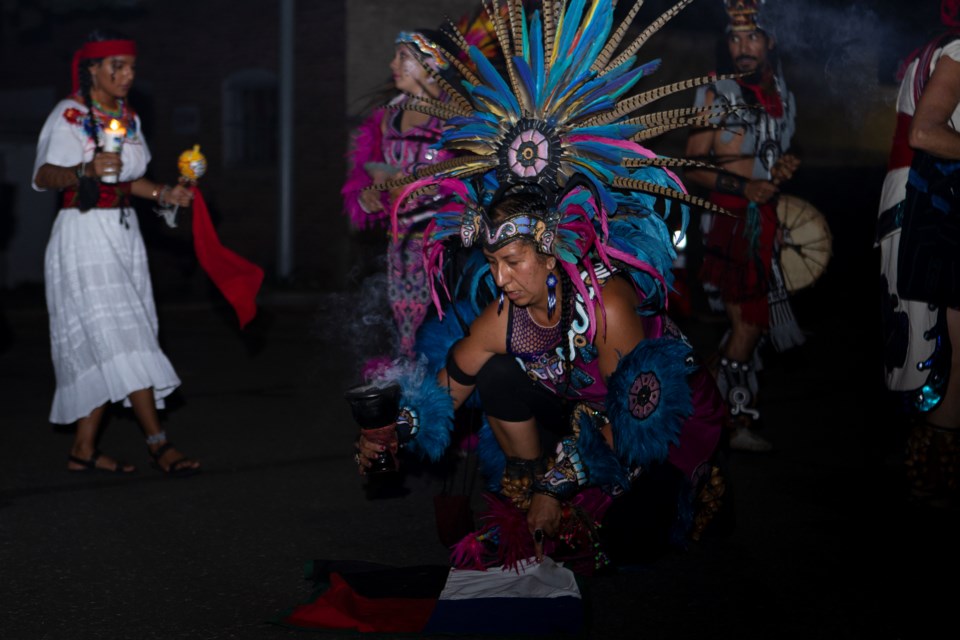 Grupo Azteca Tlahuizcalli perform in the parking lot south of the Firehouse Art Center for DÃa de los Muertos on Oct. 10. Longmont celebrated the holiday early this year onder COVID-19 restrictions. Photo by Ali C. M. Watkins
Grupo Azteca Tlahuizcalli perform in the parking lot south of the Firehouse Art Center for DÃa de los Muertos on Oct. 10. Longmont celebrated the holiday early this year onder COVID-19 restrictions. Photo by Ali C. M. Watkins
Waterman said that since a large gathering wasn’t possible this year, Firehouse moved up the celebration to coincide with the opening of the Día de los Muertos art exhibit, which opened the day before.
“We really know that our community loves this event and they want to keep coming year after year after year,” Waterman said. “And the ability to have something that was scaled down for the community was really important to us.”
The art exhibit, curated by Longmont-native Chicana artist Grace Gutierrez, was also influenced by the events of this past year. The Black Lives Matter protests pushed social unrest and racial inequities to the forefront.
Gutierrez believes that history repeats itself and it’s important to learn both about it and from it. Current events inspired her to look at Longmont’s history. Gutierrez asked four of her artist friends — Cal Duran, Javier Flores, Adrian Raya, and Ramon Trujillo — to create three altars for now passed Latinx individuals from in and around Longmont.
“I grew up in Longmont and I’ve seen it change so, so much,” Gutierrez said. “I really see a lot of displacement of Latino businesses, families in the community. So I really just want to share history, local history, so that that doesn't get lost. Lost in translation and lost in the growth of Longmont.”
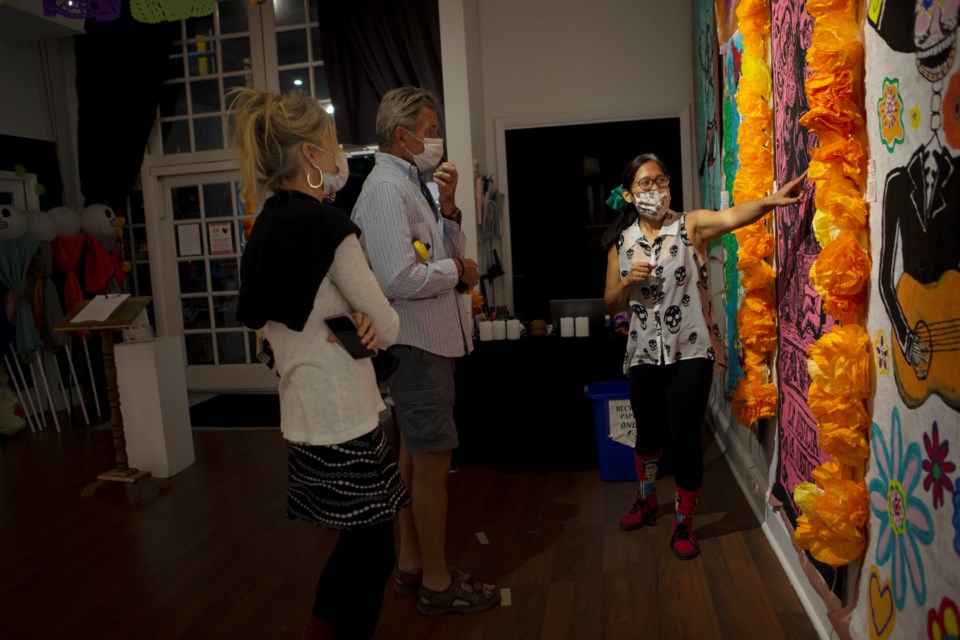 Firehouse Art Center Executive Director Elaine Waterman, right, shows a Catrina to Tom OâBanion and Dee Parker at the downtown Longmont art gallery on Oct. 9. Photo by Ali C. M. Watkins
Firehouse Art Center Executive Director Elaine Waterman, right, shows a Catrina to Tom OâBanion and Dee Parker at the downtown Longmont art gallery on Oct. 9. Photo by Ali C. M. Watkins
One altar installation celebrated Jose Hilario Cortez, a leader in the Longmont Latinx community during the 1920s who faced off with the Ku Klux Klan. Another was for Jeffrey “Beaver” Cordova and Juan Luis Garcia, two men who were shot by Longmont police in 1980. The third altar was for Los Seis de Boulder, or the six Chicano activists killed in two seperate car bombings in Boulder in 1974.
Creating altars, or ofrendas, are an important aspect of Día de los Muertos. They are usually created for deceased family members, and decorated with their favorite items and foods from when they were alive. It’s meant to welcome ancestors back to earth for a short period.
Gutierrez said that the exhibit expanded her meaning of “family,” since she curated altar pieces for people both she and the artists have never met.
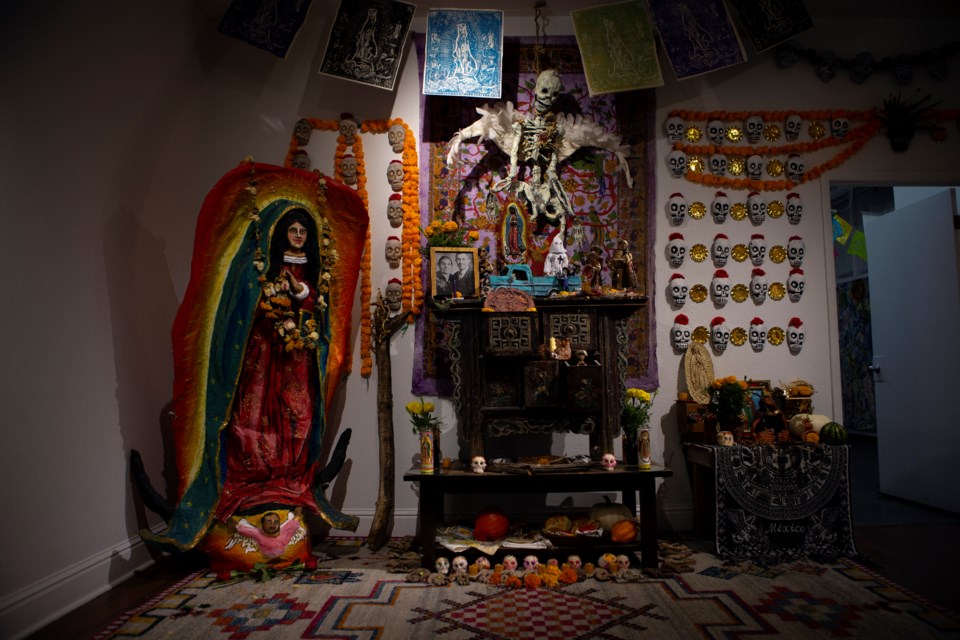 An altar by Cal Duran at the DÃa de los Muertos: Our Past and Present art exhibit at Firehouse Art Center honors Jose Hilario Cortez, a leader in the Longmont Latinx community during the 1920s who faced off with the Ku Klux Klan. The exhibit is open from Oct. 8 to Nov. 8. Photo by Ali C. M. Watkins
An altar by Cal Duran at the DÃa de los Muertos: Our Past and Present art exhibit at Firehouse Art Center honors Jose Hilario Cortez, a leader in the Longmont Latinx community during the 1920s who faced off with the Ku Klux Klan. The exhibit is open from Oct. 8 to Nov. 8. Photo by Ali C. M. Watkins
“We can still celebrate their lives and their legacies and what they were trying to do,” Gutierrez said. “It's hard to kind of like dredge up these tragedies — and some of the family members of some of these individuals have come tonight and it's hard for them to relive these moments — but I think it's just more of a way to thank these individuals for what they did and how they pushed forward the Chicano movement.”
In addition to the Our Past and Present, 20 catrina paintings by locals were displayed at Firehouse. Another 13 are at the Longmont Public Library. All are up for auction online from now until Oct. 11.
As part of the city official Día de los Muertos Longmont, Firehouse’s celebration will join a month full of mostly-virtual events. Every week of October, there will be a weekly educational content on Día de Muertos on Longmontdayofthedead.com. Next week, Firehouse will take over and about crafts, art and music.
“I think that the Latino community here in Longmont is large, strong and filled with leaders. I think that with the involvement of organizations like El Comite, Longmont Multicultural Action Committee(LMAC) and the Longmont Museum, Dia de los Muertos goes beyond just an event on the calendar,” Waterman said in a prepared statement. “It is an important opportunity to learn about other cultures, and an opportunity for the Latinx community to share their traditions. I think that Dia de los Muertos in Longmont is more than just putting up an ofrenda or painting your face. It is giving people the opportunity to share why these traditions are important to them and to come together as a community to celebrate our past.”
